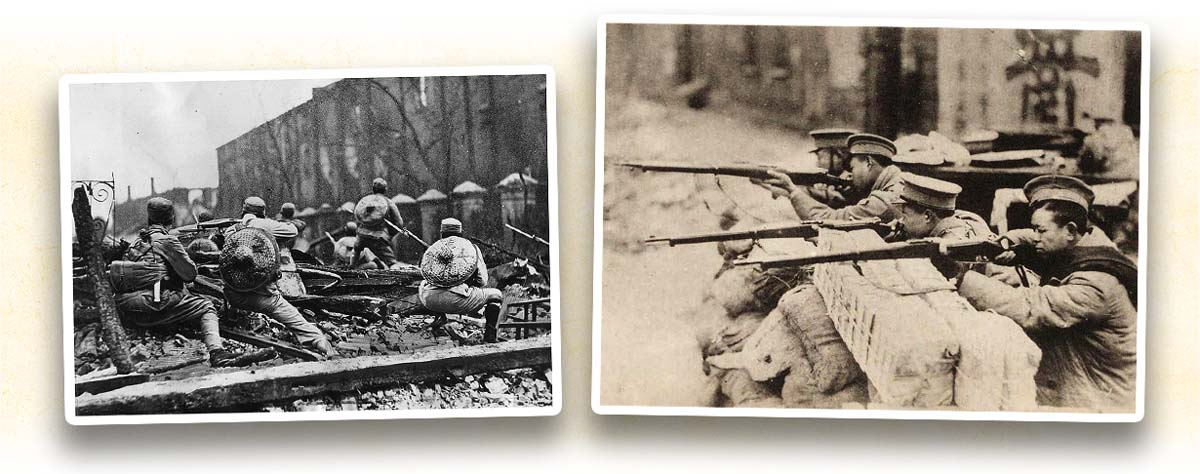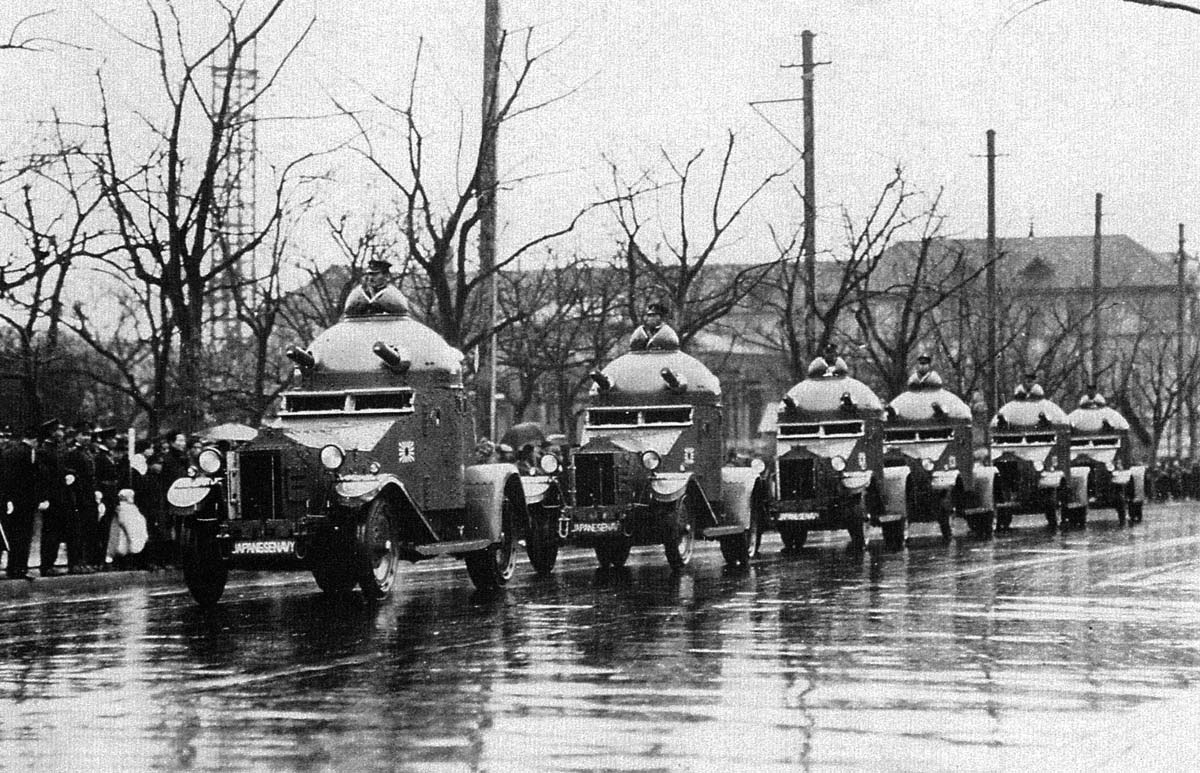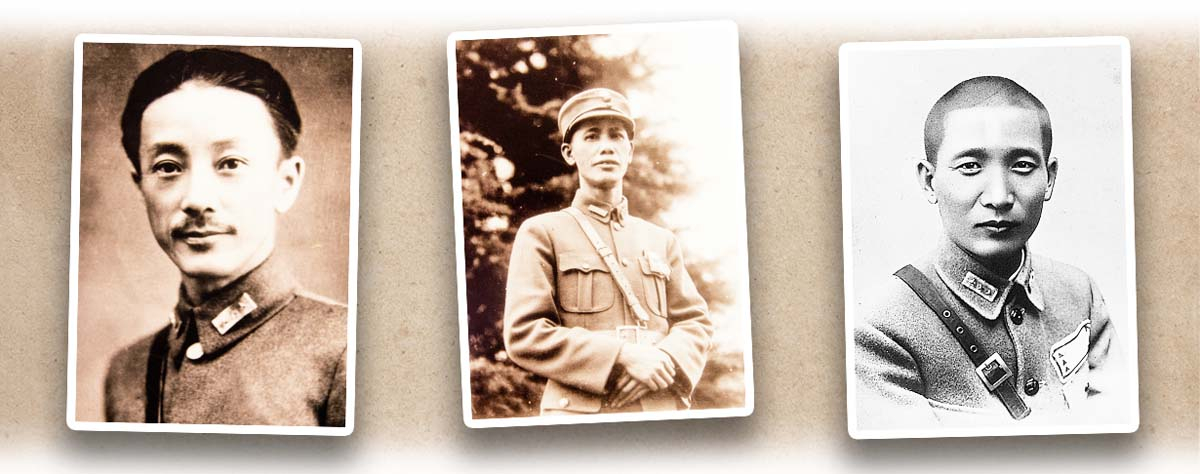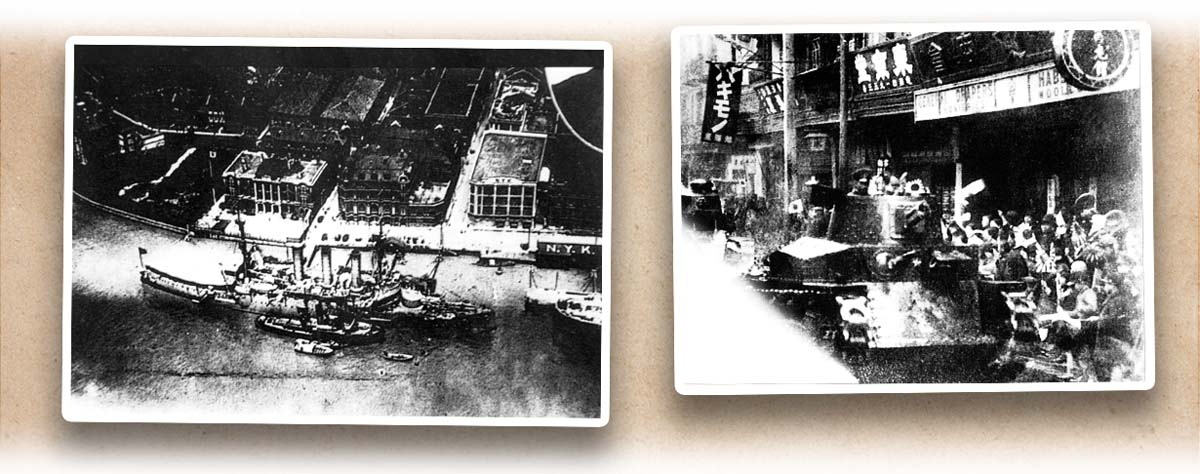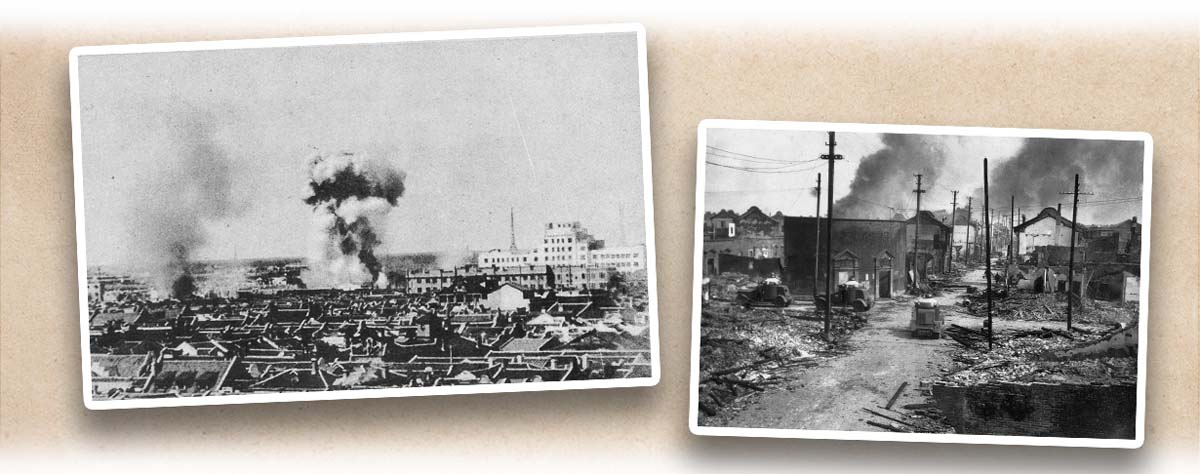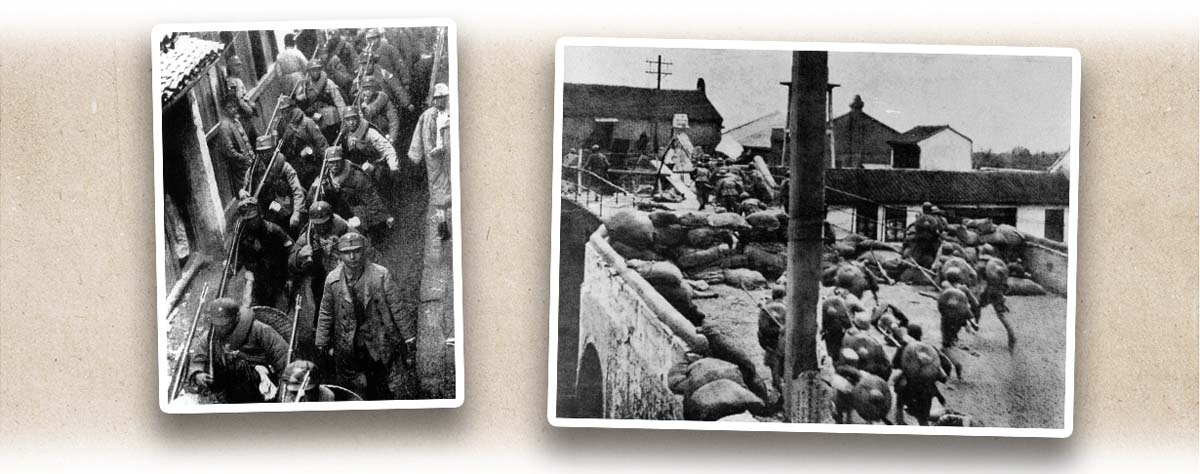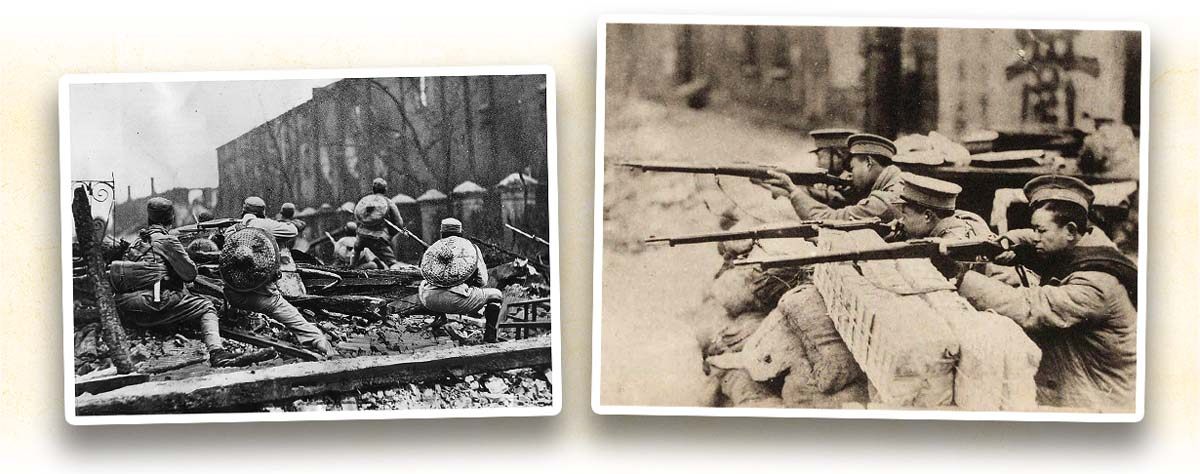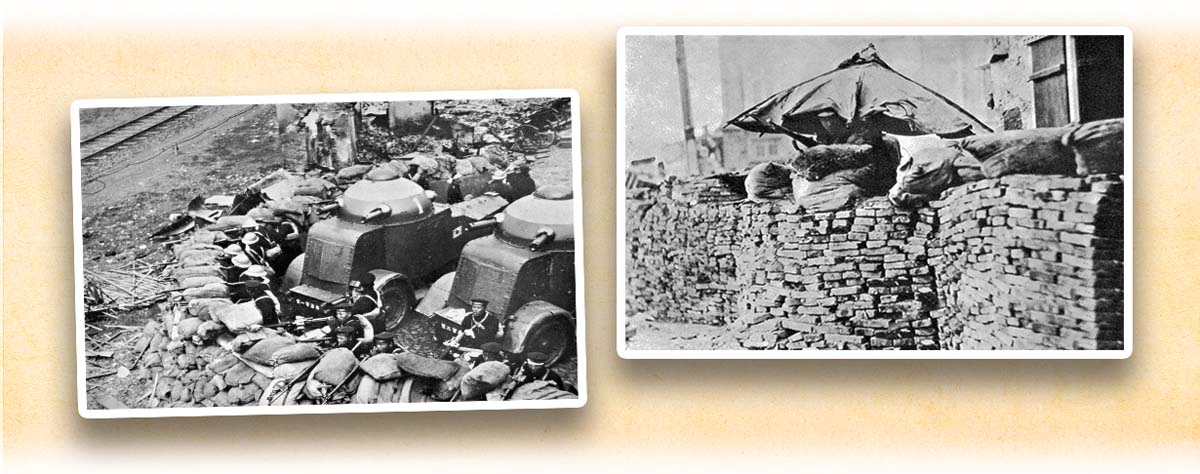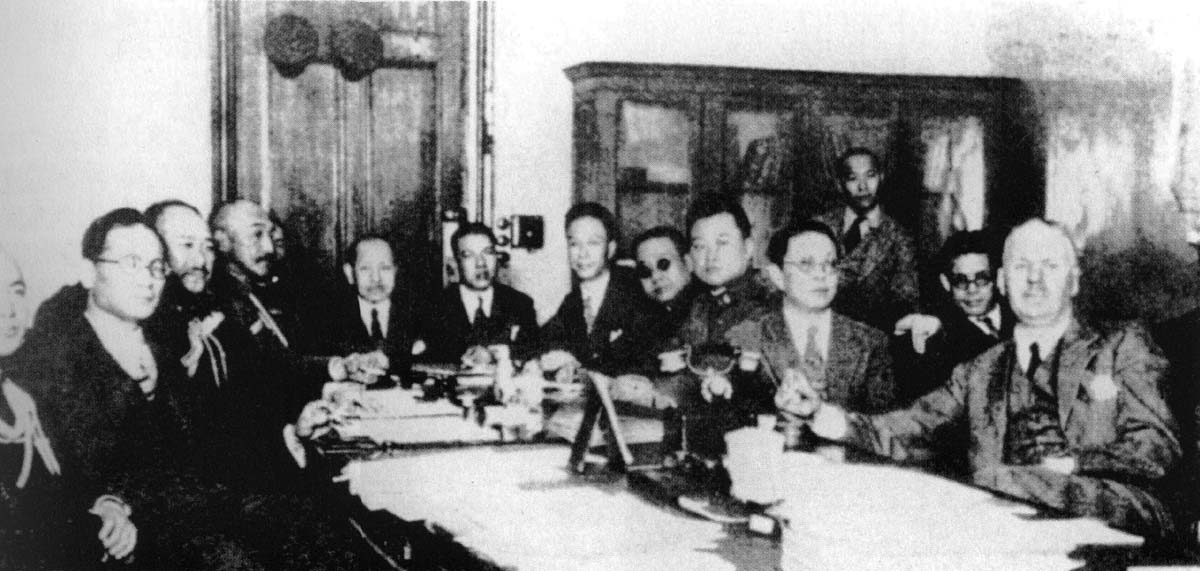The Japanese invasion of China continued after its occupation of Northeast China. In January 1932, Japan ordered Kawashima Yoshiko (sinicised name Jin Bihui﹝金璧輝﹞), a former Manchurian princess now working as a spy for Japan, to instigate an incident where Japanese monks were beaten by the Chinese. This incident, together with the boycott of Japanese products in Shanghai (上海), was used as a pretext to demand apologies, compensation, and punishment to those Chinese involved. However, without waiting for the Shanghai Government’s reply, the Japanese army, supported by a large number of warships, planes, and tanks, suddenly attacked the Chinese army stationed in Zhabei District (閘北) of Shanghai, on the night of 28 January 1932. This became known as the January 28th Incident (also the Battle of January 28th, the Shanghai Incident or the Shanghai War of 1932).
At that time, the Chinese garrison in Shanghai was the 19th Route Army led by the Nanjing (南京) and Shanghai Garrison Commander Chen Mingshu (陳銘樞). Faced with the Japanese army’s assault on Shanghai, the 19th Route Army fought back under the leadership of the Commander-in-Chief Jiang Guangnai (蔣光鼐) and the Commander Cai Tingkai (蔡廷鍇). In February, Zhang Zhizhong (張治中) led his troops to reinforce the Chinese army. At that time, the Japanese army consisted of 70,000 soldiers, and the Chinese regular army had 50,000 soldiers, with the former having an absolute advantage in terms of equipment. However, the National Revolutionary Army (NRA) strenuously fought back for more than a month, managing to repeatedly thwart the Japanese army and making it change its commander three times. In early March, the NRA was forced to retreat to the second line of defence. Under the mediation of Britain, the United States, France, and Italy, China and Japan signed a ceasefire agreement in May to end the war.
|
|
Which garrison persevered in resisting Japanese aggression during the Battle of January 28th? What were its achievements? |
|
|
See answer below. |
On 28 January 1932, Japanese armoured vehicles entered Shanghai city. That night, the Japanese army suddenly assaulted the 19th Route Army of the NRA stationed in Zhabei, triggering the outbreak of the Battle of January 28th.
The three major NRA generals commanding the Battle of January 28 in 1932. From the left: Jiang Guangnai, the Commander-in-Chief of the 19th Route Army, Cai Tingkai, the Commander of the 19th Route Army, and Zhang Zhizhong, the Commander of the 5th Corps. The 19th Route Army fought against the Japanese army from the beginning of the battle, while the 5th Corps arrived later as reinforcement.
In the Battle of January 28th, the Japanese army mobilised naval, land, and air forces to attack Shanghai. The photos show the Japanese warships and tanks used in the battle. Due to armament disparity, it was generally believed that the Japanese army would easily win the battle in a short time. The Japanese army even claimed to occupy Shanghai in just four hours.
The Japanese army launched heavy bombardments during the Battle of January 28th. Left: the Japanese army bombing Zhabei, causing explosions and fires. Right: the streets of Zhabei after the bombardments, with many buildings reduced to debris.
During the Battle of January 28th, the Japanese army launched violent attacks on Shanghai city. Left and middle: the Imperial Japanese Naval Landing Forces fighting on the streets of Shanghai. Right: the Japanese armoured vehicle and cannon team advancing in the city.
During the Battle of January 28th, the Chinese army did not cower in the face of Japan’s fierce onslaught. It resisted resolutely and even won some battles. Left: the NRA marching to the front line ready to battle the Japanese army. Right: the 19th Route Army going after the retreating Japanese army.
The Chinese troops participating in the Battle of January 28th fought against the Japanese army in many parts of Shanghai to defend every inch of land.
Left: the Imperial Japanese Naval Landing Forces built a solid position beside the Shanghai Railway Station with armoured vehicles and a large number of sandbags. Right: the Chinese army stationing in Zhabei, only equipped with light weapons. The soldiers used only loose bricks, a few sandbags, and umbrellas for shelter in the fight. As shown in these two photos, there was a significant disparity in weapons and materials between the Chinese and Japanese armies during the Battle of January 28th. Even so, the Chinese army still fought bravely. The Japanese army fell into a hard battle for more than a month but could not win, suffering over 10,000 casualties.
Left: the Scouts of Shanghai rescuing a wounded NRA soldier. Right: refugees fleeing the war crowding on the streets of Shanghai. In the Battle of January 28th , the NRA tried its best to resist the superior firepower of the Japanese army and took heavy casualties, and the people of Shanghai also suffered a lot from the war. However, the heroic fights by the NRA encouraged the soldiers and civilians in Shanghai, thus greatly boosted the morale and determination of the whole nation to resist Japanese aggression.
On 5 May 1932, China and Japan signed the Songhu Armistice Agreement (《淞滬停戰協定》, or Shanghai Ceasefire Agreement) under the mediation of the United Kingdom, the United States, France, and Italy. According to the agreement, both parties agreed to withdraw their troops and make Shanghai a demilitarised zone. However, the Chinese troops could only station in the original defence areas, while the Japanese troops could station in the Shanghai International Settlement, the area around Hongkou (虹口) and its surrounding areas.
|
|
Which garrison persevered in resisting Japanese aggression during the Battle of January 28th? What were its achievements? |
|
|
When the January 28th Incident broke out, Japan first sent cruiser Ōi, the 15th Destroyer Squadron (4 destroyers), and even aircraft carrier Notoro to carry a large number of soldiers and planes to Shanghai. At 11:30pm on 28 January, the Imperial Japanese Naval Landing Forces raided the Chinese army along North Sichuan Road (北四川路) under the cover of armoured vehicles and occupied the Shanghai-Wusong Railway Defence Line (淞滬鐵路防線) to the west. At that time, the garrison stationed in Zhabei was the 19th Route Army of the NRA led by the Commander-in-Chief Jiang Guangnai and the Commander Cai Tingkai. Their troops put up resolute resistance to the Japanese army at Tiantongan Station (天通庵車站). The next morning, Japanese planes bombed the Chinese Zone in Zhabei, destroying the printing plant of the Commercial Press and the Oriental Library. The 19th Route Army issued and spread the Circular of the 19th Route Army on the Japanese Army’s Invasion (《第十九路軍為日軍犯境通電》) nationwide, declaring that their bounden duty was to defend the territory of China. They declared that they would never give up an inch of land or grass, they would resist enemy aggression for the sake of saving the country and the nation, and they would not cower even if they had only one soldier and one bullet left. Although the 19th Route Army was far inferior to the Japanese army in terms of equipment and firepower, it fought bravely and inflicted heavy losses on the enemy. In the Battle of the Caojia Bridge (曹家橋) in mid-February, 1,600 Japanese soldiers were wiped out, and Japan’s attempt to occupy Wusong (吳淞) in one blow failed. The 5th Army, the reinforcements led by Zhang Zhizhong, also won the Battle of Miaoxing Town (廟行). Afterwards, the Japanese army sent an ultimatum to Cai, demanding the 19th Route Army to retreat 20 kilometres from the first line on 20 February morning. However, this demand was sternly refused. On 20 February, the Japanese army launched the final assault, but the NRA maintained high morale and fought back heroically. In just two weeks, the Japanese army suffered heavy losses. During this battle, the Japanese army was forced to send reinforcements several times and change commanders three times, suffering more than 10,000 casualties. Even at such great cost, they were still not able to win the battle and had to sign a ceasefire agreement. During the Battle of January 28th, the sacrificial spirit of the 19th Route Army and the 5th Corps in fighting against Japan to save the country was a great inspiration to the Chinese people. However, the Nationalist Government led by Chiang Kai-shek (蔣介石) implemented the policy of “first internal pacification, then external resistance”. Soon after the January 28th Incident, Chiang declared the relocation of the capital to Luoyang (洛陽) on 30 January, and it was not until 1 December that Nanjing was restored as the capital. Later, the 19th Route Army was withdrawn from Shanghai and transferred to Fujian Province (福建) to suppress the Communists. This led to the Fujian Incident in November 1933, the purpose of which was to resist Japanese aggression and oppose Chiang. After the rebellion was suppressed, the designation of the 19 Route Army was cancelled. |
Source of most photos used in this feature piece: Fotoe (pictures 1-6, and pictures 8-10) and misc. photo sources.




